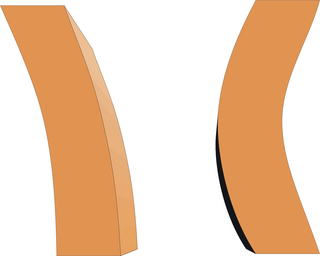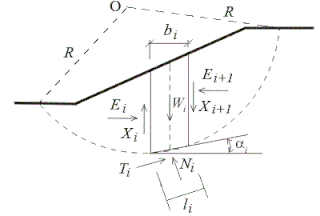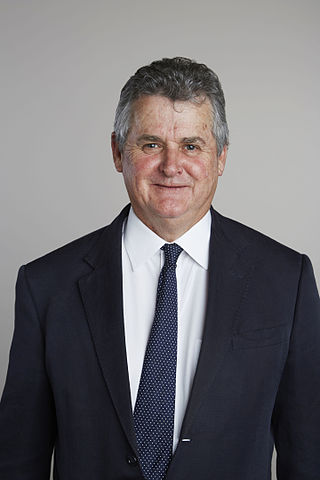
Geotechnical engineering, also known as geotechnics, is the branch of civil engineering concerned with the engineering behavior of earth materials. It uses the principles of soil mechanics and rock mechanics to solve its engineering problems. It also relies on knowledge of geology, hydrology, geophysics, and other related sciences.

Soil liquefaction occurs when a cohesionless saturated or partially saturated soil substantially loses strength and stiffness in response to an applied stress such as shaking during an earthquake or other sudden change in stress condition, in which material that is ordinarily a solid behaves like a liquid. In soil mechanics, the term "liquefied" was first used by Allen Hazen in reference to the 1918 failure of the Calaveras Dam in California. He described the mechanism of flow liquefaction of the embankment dam as:
If the pressure of the water in the pores is great enough to carry all the load, it will have the effect of holding the particles apart and of producing a condition that is practically equivalent to that of quicksand... the initial movement of some part of the material might result in accumulating pressure, first on one point, and then on another, successively, as the early points of concentration were liquefied.

Earthworks are engineering works created through the processing of parts of the earth's surface involving quantities of soil or unformed rock.

Seismic analysis is a subset of structural analysis and is the calculation of the response of a building structure to earthquakes. It is part of the process of structural design, earthquake engineering or structural assessment and retrofit in regions where earthquakes are prevalent.
In geotechnical civil engineering, the p–y is a method of analyzing the ability of deep foundations to resist loads applied in the lateral direction. This method uses the finite difference method and p-y graphs to find a solution. P–y graphs are graphs which relate the force applied to soil to the lateral deflection of the soil. In essence, non-linear springs are attached to the foundation in place of the soil. The springs can be represented by the following equation:

A deep foundation is a type of foundation that transfers building loads to the earth farther down from the surface than a shallow foundation does to a subsurface layer or a range of depths. A pile or piling is a vertical structural element of a deep foundation, driven or drilled deep into the ground at the building site.

The finite element method (FEM) is a popular method for numerically solving differential equations arising in engineering and mathematical modeling. Typical problem areas of interest include the traditional fields of structural analysis, heat transfer, fluid flow, mass transport, and electromagnetic potential.
Z88 is a software package for the finite element method (FEM) and topology optimization. A team led by Frank Rieg at the University of Bayreuth started development in 1985 and now the software is used by several universities, as well as small and medium-sized enterprises. Z88 is capable of calculating two and three dimensional element types with a linear approach. The software package contains several solvers and two post-processors and is available for Microsoft Windows, Mac OS X and Unix/Linux computers in 32-bit and 64-bit versions. Benchmark tests conducted in 2007 showed a performance on par with commercial software.
LUSAS is a UK-based developer and supplier of Finite Element Analysis (FEA) application software products that bear the same name.

Klaus-Jürgen Bathe is a civil engineer, professor of mechanical engineering at the Massachusetts Institute of Technology, and founder of ADINA R&D, who specializes in computational mechanics. Bathe is considered to be one of the pioneers in the field of finite element analysis and its applications.

Slope stability analysis is a static or dynamic, analytical or empirical method to evaluate the stability of slopes of soil- and rock-fill dams, embankments, excavated slopes, and natural slopes in soil and rock. It is performed to assess the safe design of a human-made or natural slopes and the equilibrium conditions. Slope stability is the resistance of inclined surface to failure by sliding or collapsing. The main objectives of slope stability analysis are finding endangered areas, investigation of potential failure mechanisms, determination of the slope sensitivity to different triggering mechanisms, designing of optimal slopes with regard to safety, reliability and economics, and designing possible remedial measures, e.g. barriers and stabilization.
SVSLOPE is a slope stability analysis program developed by SoilVision Systems Ltd.. The software is designed to analyze slopes using both the classic "method of slices" as well as newer stress-based methods. The program is used in the field of civil engineering to analyze levees, earth dams, natural slopes, tailings dams, heap leach piles, waste rock piles, and anywhere there is concern for mass wasting. SVSLOPE finds the factor of safety or the probability of failure for the slope. The software makes use of advanced searching methods to determine the critical failure surface.
ADINA is a commercial engineering simulation software program that is developed and distributed worldwide by ADINA R & D, Inc. The company was founded in 1986 by Dr. Klaus-Jürgen Bathe, and is headquartered in Watertown, Massachusetts, United States. On April 7, 2022, Bentley Systems acquired ADINA R&D, Inc.
A finite element limit analysis (FELA) uses optimisation techniques to directly compute the upper or lower bound plastic collapse load for a mechanical system rather than time stepping to a collapse load, as might be undertaken with conventional non-linear finite element techniques. The problem may be formulated in either a kinematic or equilibrium form.

VisualFEA is a finite element analysis software program for Microsoft Windows and Mac OS X. It is developed and distributed by Intuition Software, Inc. of South Korea, and used chiefly for structural and geotechnical analysis. Its strongest point is its intuitive, user-friendly design based on graphical pre- and postprocessing capabilities. It has educational features for teaching and learning structural mechanics, and finite element analysis through graphical simulation. It is widely used in college-level courses related to structural mechanics and finite element methods.
The Newmark's sliding block analysis method is an engineering that calculates permanent displacements of soil slopes during seismic loading. Newmark analysis does not calculate actual displacement, but rather is an index value that can be used to provide an indication of the structures likelihood of failure during a seismic event. It is also simply called Newmark's analysis or Sliding block method of slope stability analysis.
The Sarma method is a method used primarily to assess the stability of soil slopes under seismic conditions. Using appropriate assumptions the method can also be employed for static slope stability analysis. It was proposed by Sarada K. Sarma in the early 1970s as an improvement over the other conventional methods of analysis which had adopted numerous simplifying assumptions.
David Malcolm Potts is a professor of Analytical Soil Mechanics at Imperial College London and the head of the Geotechnics Section at Imperial College. He has been a member of the academic staff at Imperial College since 1979, responsible for teaching the use of analytical methods in geomechanics and the design of slopes and earth retaining structures, both at undergraduate and postgraduate levels.

Medhat Haroun was an Egyptian-American expert on earthquake engineering. He wrote more than 300 technical papers and received the Charles Martin Duke Lifeline Earthquake Engineering Award (2006) and the Walter Huber Civil Engineering Research Prize (1992) from the American Society of Civil Engineers.

Scott William Sloan FRS FREng FAA FTSE was laureate Professor of Civil Engineering at the University of Newcastle.









